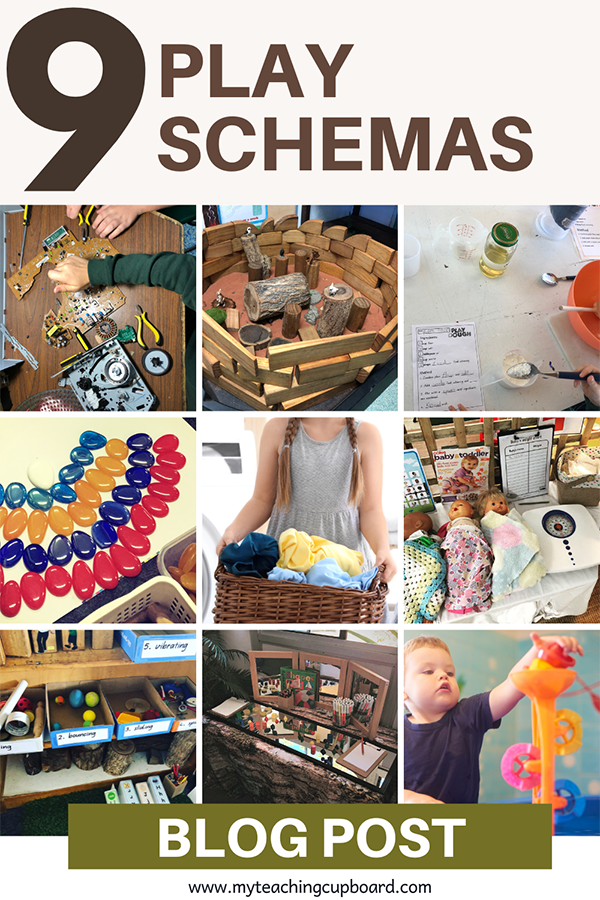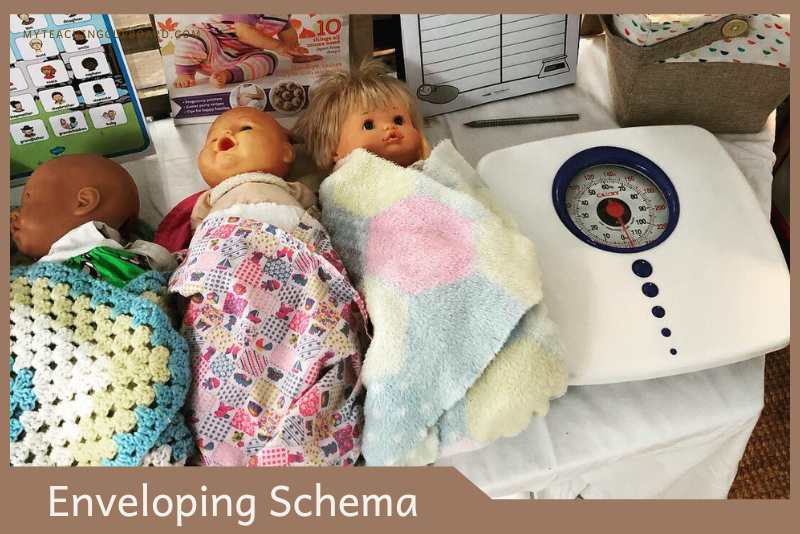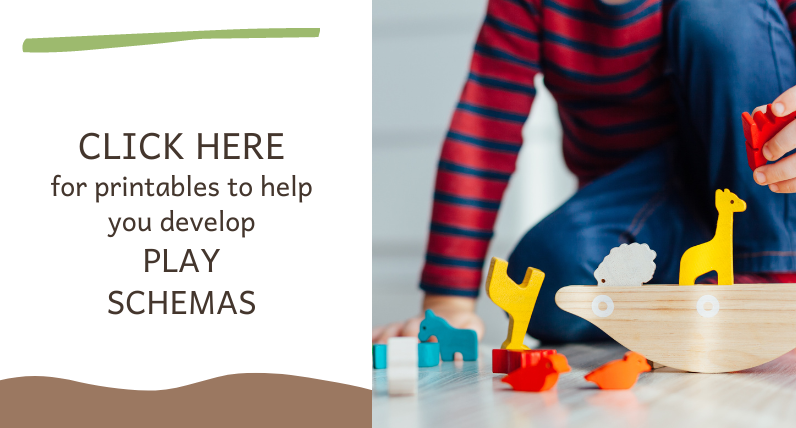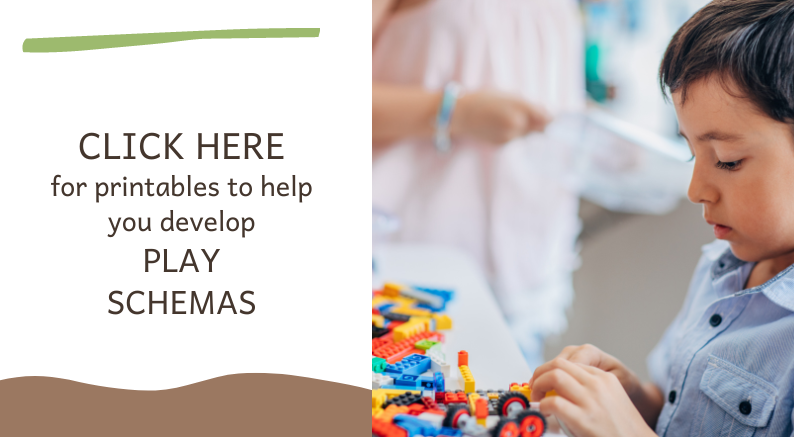A Guide to Play Schemas in Early Childhood Education
This guide to play schemas in early childhood education explains what play schemas are and how you can use 9 play schemas to effectively teach the children in your class.
If you would like to create an engaging and effective learning environment and confidently plan learning experiences that match the cognitive development of each child in your class, this blog post on play schemas is definitely for you.
Understanding play schemas and being able to pinpoint the ones your students are developing is critical to the success of your early childhood classroom.
Get ready for confirmation that an age-appropriate, play-based pedagogy is what every child needs and deserves. You are going to discover just how important schema play theory really is.
What are Play Schemas?
We use schemas to organise and build our knowledge. A schema is like the basic building block of intelligence and behaviour. We use these building blocks to create cognitive models to help us understand our world.
Schema can be defined as a set of linked mental representations of the world. We use our schema to both understand and respond to situations. We mentally store away our schema to apply them whenever we need them.
Jean Piaget was one of the first to use the term schema way back in 1923. He was considered an important child development theorist back then. In fact, his Theory of Cognitive Development still is incredibly influential.
Piaget was a Swiss psychologist who created theories of cognitive development. He based his theories on observations he made of children in the early 1900s. Piaget described schemas as units of knowledge. Each schema relates to one aspect of the world - objects, actions, and abstract or theoretical.
He defined a schema as a cohesive, repeatable action sequence possessing component actions that are tightly interconnected and governed by a core meaning.
Schemata are like index cards filed in the brain. Each little index card tells you how to react to incoming stimuli or information.
Piaget emphasized the importance of schemas in cognitive development. He explained how schemas were developed or acquired. According to Piaget, children are born with a very basic mental structure. He observed children building new concepts and knowledge based on their prior knowledge and already formed schemas.
If you would like to learn more about Piaget and his stages of development, you might be interested in this blog post: Stages of Development - Piaget
Piaget’s theory of cognitive development has significantly contributed to developmental psychology and education. I often refer to his theories because they explain the relationship between play and cognition. Piaget views play and cognitive thinking as being deeply intertwined.
“Using play to facilitate cognition is based on the Piagetian stages found in the sensorimotor period which is birth to 2 years. Two critical processes involved in the learning process is the assimilation of new knowledge and the accommodation of new experiences with their existing schemas or internal organized patterns of thought and behaviour. ”
What is Schema Play Theory?
Piaget was one of the first to talk about and document schema play theory. He was also the first to suggest children think differently from adults.
Piaget observed and documented children and their natural desire to learn. He suggested that children learn by constantly taking in information from the world around them to build their schema.
He also noticed that children of a similar age would play in what he described as developmental stages. This led him to suggest that learning happens in stages too. Piaget’s theory explains how schema play supports children in their learning. He suggests it can also help them to move through the developmental stages. You can read more about it here in this blog post – Developmental Stages of Play - Piaget
A major part of Piaget’s Theory of Cognitive Development is about schema and schemata play theory. He theorized that children have three schemata:
Symbolic Schemata
Operational Schemata
Behavioural Schemata
This blog post will be about Behavioural Schemata, and what is often referred to as Play Schema Theory.
The theory of play schemas has been studied and developed by many professionals since Piaget first introduced his theory in the early 1900s.
Richard Anderson, an Educational Psychologist, was one of the first researchers to make us aware of the implications of using children’s schema to inform and help educators.
In his paper - The Notion of Schemata and the Educational Enterprise: General Discussion of the Conference, (1977) he discussed the importance of play schemas in education.
Chris Athey is another prominent professional using Piaget’s theories to highlight the need to understand play schemas in education. She is a constructivist educator and was the director of the Froebel Early Education Project in the 70s. This was a ground-breaking study in understanding the way young children think.
For Athey, schemas are those patterns of behaviour and thinking in children that exist and evolve, and which may be represented by actions, language, and symbolic play. The repeated nature of behaviours can show a pattern, which may reflect a child’s interest in a concept or the properties of materials/objects they are using.
Schemas can be multi-layered and, therefore, developmental – several schemas may be developing at the same time, which means thinking develops through making connections and making sense of experiences and ideas. This development should be supported by a curriculum that enables children to develop their schemas/ways of thinking by responding to the world through active participation, and through the powerful medium of play. (Pioneers: Chris Athey and John Dewey. 2021)
9 Play Schemas You Need to Know About
Schemas are repeated patterns of behaviour that you notice children doing when they play. Nine schemas can be commonly observed in young children.
Connection
Children building their connection schema are learning how things connect and separate. They would be exploring concepts of size and shape and the forces of pushing and pulling too. You will notice these children are fascinated with construction sets like Lego. They will enjoy joining things together, tying things up, and dismantling objects as well.
These children will be drawn to your Tinkering area and will love working with real tools like screwdrivers. They are also interested in the arts and collage space where they can glue and stick things together. Children developing their connecting schema will work for extended periods of time connecting and disconnecting objects or joining and separating things.
You can read more about this schema here: The Connecting Schema
2. Transforming
Children with a transformation schema are interested in change. They will be keen to explore any objects changing in appearance or substance. Sometimes these children might be interested in lifecycles and how living things transform or change too.
Children building their transformation schema are building an understanding of cause and effect. Sensory play, play dough, and mixing paint or mud kitchen ingredients will be highly engaging activities for these students. Most of the science experiments you do, especially in Chemistry, are going to be perfect for children developing the transformation schema.
You can read more about this schema here: The Transforming Schema
3. Orientation
Children building their orientation schema are interested in how objects look from different angles and perspectives. If you notice your children hanging upside down in the playground or bending over to see things through their legs, they are developing their orientation schema. Sometimes you might even notice them turning objects over to look at them from a new angle.
These children will enjoy experimenting with magnifying glasses, mirrors, and reflections and can even show an interest in balancing objects or exploring height and weight. They will be in their element when you study map making and how to view places using a bird’s eye view in Geography.
You can read more about this schema here: The Orientation Schema
4. Trajectory
Exploring movement and the Science unit on How Things Move is going to grab the attention of children developing their trajectory schema. This schema is all about movement.
Children building the trajectory schema will love experimenting with direction, force and motion, and cause and effect. If you have a student who is always throwing objects and watching them as they land, you probably have a child developing their trajectory schema.
Developmentally, this schema is supposed to be one of the earliest schemas that young children explore but I have had many children still developing this schema in preschool and kindergarten. They benefit from activities involving toy cars, paper planes, spinning objects, marble runs, and anything to do with balls.
You can read more about this schema here: The Trajectory Schema
5. Rotation
Related to the trajectory schema is the rotation schema. This schema is all about objects that turn, spin, or rotate. Primarily this schema involves their own bodies, balance, and coordination.
In preschool and kindergarten, you will notice children exploring anything that rotates – including their own bodies as well as objects. That child turning the taps on and off? …Yes!! They are exploring the rotation schema.
Use salad spinners, wheels, hoops, water wheels, windmills and even winding wool around objects for engaging activities that will help them to build their rotation schemas.
You can read more about this schema here: The Rotation Schema
6. Enveloping
An enveloping schema is an interest in wrapping up objects or themselves. As children explore the enveloping schema you will notice them completely wrapping up objects or covering whole pieces of paper in one colour. They like to create cubbies to hide in too.
When children are developing the enveloping schema, they are building measurement concepts around shape, space, and volume. Box construction and makerspaces are popular investigation areas for children exploring this schema.
You can read more about this schema here: The Enveloping Schema
7. Enclosing
This schema is often observed in block play and in dramatic play. Students building their enclosure schema are always creating boundaries and borders to contain objects or themselves.
You will notice them building enclosures like fences and walls with the blocks and other small world play objects. They love to wrap up dolls and toys in the dramatic play space. Sometimes you might even notice them enclosing their own bodies by wrapping themselves up in fabrics or hiding in small spaces.
You can read more about this play schema here: The Enclosing Schema
8. Positioning
Children building their positioning schema are often lining objects up or placing them in some type of careful alignment. The positioning of objects will involve stacking and won’t always be about aligning objects alongside each other either.
These children are learning all about classification, order, sequences, shape, symmetry, and creating patterns. Repeating patterns are of great interest to children developing this schema too. So many math concepts rely on a student’s understanding of the positioning schema.
You can read more about this play schema HERE: The Positioning Schema
9. Transporting
Do you have children carrying objects from one place to another or moving them around the classroom? No doubt they are building their transporting schema.
These children will be learning about where things belong. They are often building concepts of distance and mapping out their environment too. Provide these little learners with containers – buckets, baskets, bowls, bags, and lots of loose parts like blocks, counters, stones, and even water (if you are game 😊)
You can read more about this play schema here - The Transporting Play Schema
The schemas that children form aren't always right. You have probably noticed children in your class that have misconceptions. These children have formed incorrect schemas.
That’s what makes a schema unique. Schemas represent our current knowledge and understanding. Over time, as children investigate and explore, they will begin to realise that there are gaps or misconceptions in their understandings.
We can all modify our schema to reflect any new information. The beauty of an investigative, play-based pedagogy is that it will consistently allow your students to explore and modify their existing schemas.
Why Are Play Schemas Important?
As you can see, knowledge of your children and the play schemas they are working on can help you to deepen and individualise the learning experiences you offer in your play-based classroom.
Engagement will rise if you offer learning invitations specifically designed to address the play schemas relevant to your student’s development. Your children will be completely immersed in any activity that speaks to the schema they are developing.
Investigations and play experiences can be thoughtfully curated to encourage children to modify any schema misconceptions they may have. You can also design learning investigations that can help children play at a deeper level and expand on their learning of particular schemas.
When children have the opportunity to develop schemas that are personally relevant to them, they flourish. They will be engaged and on task. They will be happy to learn something developmentally relevant and of interest to them. There is no sense of failure in this type of learning and their self-esteem soars.
Be prepared for accelerated progress when you match your learning invitations to the schemas your students are developing. All you need to do is provide the appropriate learning invitation and then step out of the way. Children are naturally wired to learn and if their learning space offers experiences aligned to their play schemas, you won’t be able to stop them from learning - even if you tried.
Play schemas are important if you want to understand the brain and how a child learns. If you are interested in differentiating your curriculum and adapting it to suit the needs of your students, play schemas will be important for you.
And finally, those undesirable behaviours that often have us tearing our hair out and asking WHY?
If you want to understand behaviours, especially those undesirable ones, play schemas are very important for you. If you understand schemas, you will be able to modify behaviours by changing the undesirable ones to purposeful educational activities which are aligned with what each child needs.
If you want to plan and provide age-appropriate and developmentally relevant learning experiences which are engaging and perfect for your students – play schemas are important!!
What Does Schemas Mean For Early Childhood Education?
Understanding play schemas is vital if you are a play-based learning teacher. There are so many educational implications:
promotes discovery learning
informs the planning of investigations and learning invitations
caters to individualised or personalised learning
creates a flexible curriculum
develops an enhanced learning environment
helps to create an environment that becomes your third teacher
fosters problem-solving skills and critical thinking
creates independent learners
builds a learner’s self-esteem
provides an age-appropriate curriculum
supports a child-led curriculum
informs assessments and teacher observations
Piaget suggests classroom learning must be student-centered. His theory argues assimilation and accommodation cannot be taught. They can only be discovered by an active learner.
Therefore, the teacher must take on the role of a facilitator of learning in early childhood education. Yes, direct and explicit teaching has its place in the early year’s classroom, but it needs to be balanced with active hands-on exploration or investigations.
Play-based learning is the best pedagogy to support and enrich the schematization process in children.
I am passionate about this type of learning and have designed many resources to help me facilitate a play-based pedagogy in my classroom. If you are interested in resources to help you teach through active hands-on investigations or explorations too, you can check them out HERE.
Our understanding of play schemas and how children learn implies teachers need to focus on the process of learning, rather than the end product of it.
When you understand play schemas, you realise we need to use active methods that allow our students to rediscover or reconstruct truths.
A solid knowledge of play schemas will help you to correctly evaluate each child’s developmental needs. This can then help you to differentiate your curriculum and your teaching. So, you will be able to plan effective and appropriate learning invitations and lessons.
CONCLUSION
I hope this blog post has given you some inspiration to create a learning environment and a curriculum that supports the schematic cognitive development of the children you work with.
When you use developmentally appropriate play invitations, you will definitely enrich the schemas your children are building. Understanding the play schemas your children are developing and then acting on this information will lead to an engaging and effective early childhood classroom.
If you found this Guide to Play Schemas in Early Childhood Education useful, others might too. Please consider sharing it…
Just CLICK the sharing box below.👇


















